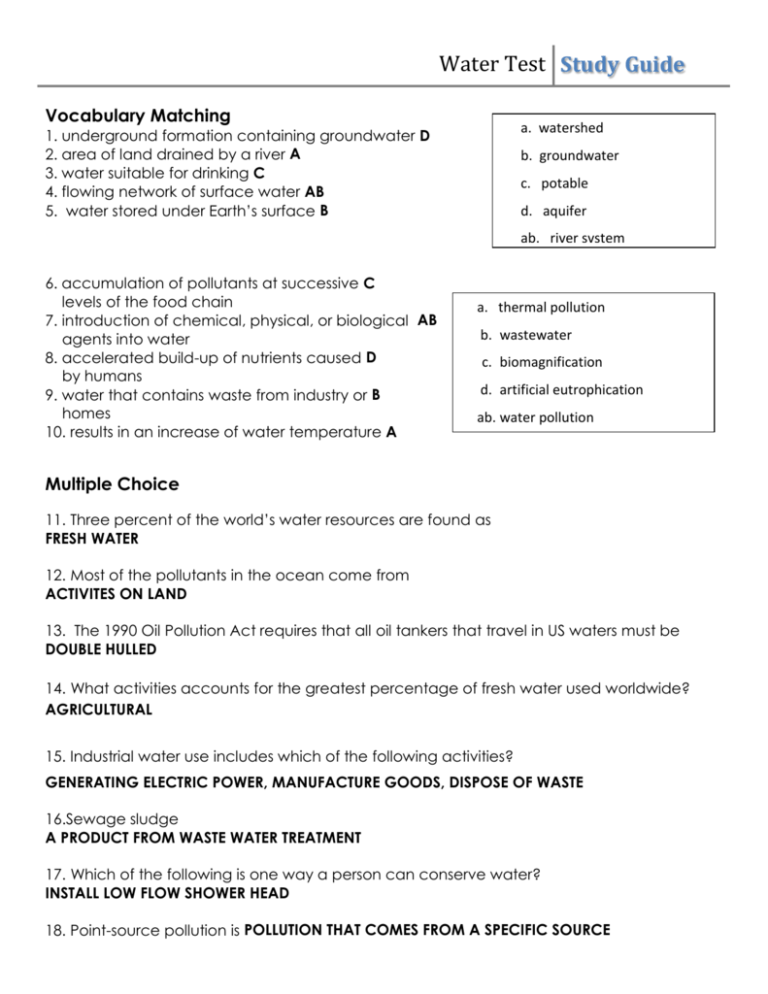Water Test Study Guide Answers
advertisement

Water Test Study Guide Vocabulary Matching a. watershed 1. underground formation containing groundwater D 2. area of land drained by a river A 3. water suitable for drinking C 4. flowing network of surface water AB 5. water stored under Earth’s surface B b. groundwater c. potable d. aquifer ab. river system 6. accumulation of pollutants at successive C levels of the food chain 7. introduction of chemical, physical, or biological AB agents into water 8. accelerated build-up of nutrients caused D by humans 9. water that contains waste from industry or B homes 10. results in an increase of water temperature A a. thermal pollution b. wastewater c. biomagnification d. artificial eutrophication ab. water pollution Multiple Choice 11. Three percent of the world’s water resources are found as FRESH WATER 12. Most of the pollutants in the ocean come from ACTIVITES ON LAND 13. The 1990 Oil Pollution Act requires that all oil tankers that travel in US waters must be DOUBLE HULLED 14. What activities accounts for the greatest percentage of fresh water used worldwide? AGRICULTURAL 15. Industrial water use includes which of the following activities? GENERATING ELECTRIC POWER, MANUFACTURE GOODS, DISPOSE OF WASTE 16.Sewage sludge A PRODUCT FROM WASTE WATER TREATMENT 17. Which of the following is one way a person can conserve water? INSTALL LOW FLOW SHOWER HEAD 18. Point-source pollution is POLLUTION THAT COMES FROM A SPECIFIC SOURCE Water Test Study Guide 19.What is an example of nonpoint source pollution? WATER RUNOFF 20. When neighborhood residents noticed a large number of dead fish in a local creek, they traced the problem to a nearby gas station. It turned out that a gasoline tank had developed a leak. This is an example of POINT SOURCE POLLUTION 21. There are two types of water found on Earth; they are: FRESH WATER AND SALT WATER 22. The fresh water we use comes mainly from _________________________________________ and from a relatively narrow zone beneath the Earth’s surface. LAKES AND RIVERS 23. The _________________________________________ system is the largest river system in the United States. MISSISSIPPI RIVER 24. The two underlying causes of water pollution are RAPID HUMAN POPULATION GROWTH AND INDUSTRIALIZATION 25. ______________________________________________ is pollution that comes from many sources rather than from a single specific site. NON-POINT SOURCE 26. If the toxicity of sludge can be reduced to safe levels, it can be used as a FERTILIZER 27. Pollutants usually enter groundwater when polluted surface water ____________________________ down from the Earth’s surface. PERCOLATES 28. _____________________________________ was to designed to “restore and maintain the chemical, physical, and biological integrity of the nation’s waters.” THE CLEAN WATER ACT 1972 29. __________________ pollution is one of the world’s most pressing environmental problems in the world. GROUNDWATER 30. _____________________________ is a temperature increase in a body of water. THERMAL POLLUTION Water Test Study Guide 31. __________________________ is a process that increases the amount of nutrients in a body of water through human activities, such as waste disposal and land drainage. ARTIFICIAL EUTROPHICATION 32.Most nutrients in water come from ______________________________, such as leaves and animal waste that is broken down into mineral nutrients by decomposers such as bacteria and fungi. ORGANIC MATTER 33. Most of the water loss in agriculture comes from __________________________. IRRIGATION 34. ____________________ is an example of a reservoir in Georgia. LAKE LANIER 35. Most water must first be made potable. The word potable means what? DRINKABLE 36. The three major uses for water are _________________________________________________ AGRICULTURE, INDUSTRIAL, RESIDENTIAL 37. According to the World Health Organization, more than ____________________________ people lack access to a clean, reliable source of fresh water. 1 BILLION 38. The average person in the United States uses about ________________________ of water a day. 300 L 39. A _________________________ is a structure that is built across a river to control a river’s flow. DAM 40. Hydroelectric dams use the power of flowing water to turn a _______________________ that generates electrical energy TURBINE Water Test Study Guide TRUE or FALSE ______41. When organic matter builds up in a body of water, it will begin to decay and decompose. TRUE ______42. Water-saving technology, such as low-flow toilets, can also help increase household water use. FALSE ______43. Desalination is the process of removing salt from ocean water. TRUE ______44. Cooking and drinking is the majority of daily residential water use in the United States. FALSE ______45. A pathogen is a virus, microorganism, or other substance that causes disease. TRUE SHORT ANSWERS 46. List 5 ways a person can conserve water. 47. Describe the difference between point-source pollution and nonpoint-source pollution. POINT SOURCE POLLUTION COMES FROM A SPECIFIC SITE WHERE AS NON POINT SOURCE COMES FROM MANY SOURCES 48. List an example of point source pollution and an example of nonpoint source pollution. POINT SOURCE – LEAKING SEPTIC TANK, NON POINT SOURCE – WATER RUNOFF 49. Why is polluted ground water difficult to clean? IT IS DIFFICULT TO CLEAN BECAUSE OF THE VARIOUS TYPES OF POLLUTANTS IN THE WATER. THE MIXTURE OF THE POLLUTANTS MAKE IT DIFFICULT TO SEPARATE AND REMOVE. 50. Why is freshwater a limited resource? FRESHWATER IS A LIMITED RESOURCE BECAUSE 77% OF IT IS LOCATED IN ICE CAPS AND GLACIERS.





